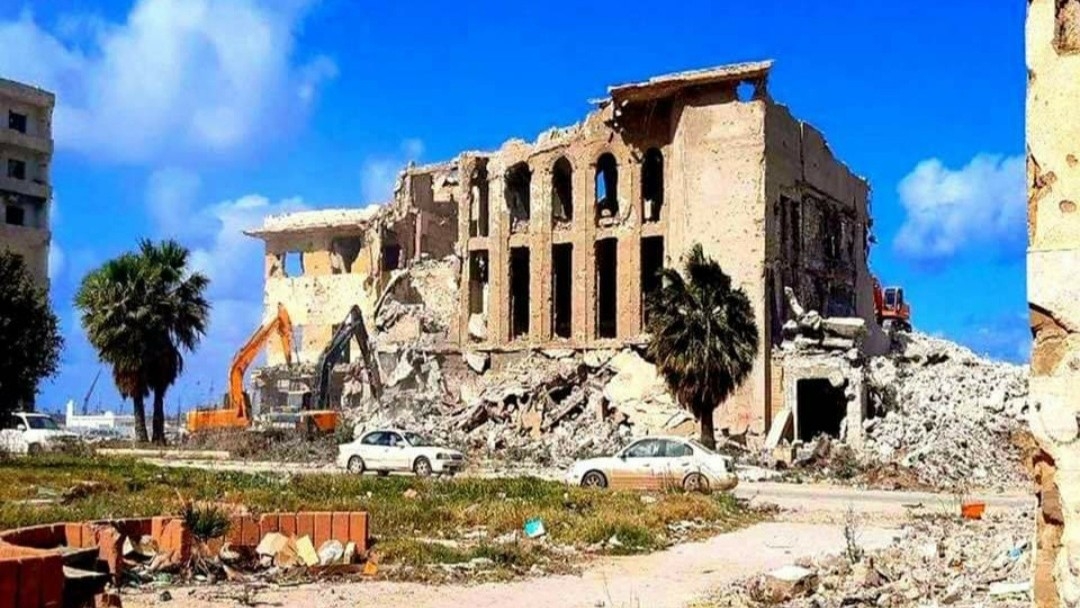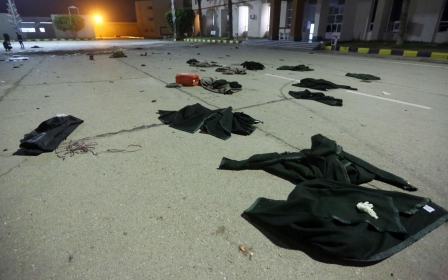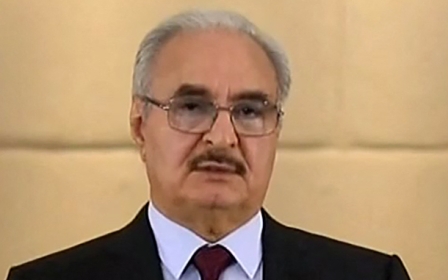Libya: Demolition of Italian-era buildings in Benghazi seen as attack on city's heritage

The destruction of Italian colonial-era buildings in the old city of Benghazi in Libya has triggered warnings of the consequences for the city's architectural heritage.
In March, soldiers affiliated with the armed group Tariq Ben Zeyad, led by Saddam Haftar, son of eastern Libya military commander Khalifa Haftar, demolished several properties that were built during the fascist occupation of the country in the early 20th century. Amongst the affected structures were some in the heart of the old city, specifically along Omar al-Mokhtar street.
Local sources reported that the troops belonging to the militia, which forms part of the Libyan National Arab Army under the command of General Haftar, were responsible for the destruction.
Notable landmarks such as the Berenice theatre, designed by architect Marcello Piacentini in the 1920s, along with the former headquarters of the Banco di Roma, the Cassa di Risparmio della Cirenaica (the Savings Bank of Cyrenaica), Silphium Square and the Prosdocimi palace have been targets for demolition.
A video recorded by a local resident captured the sight of numerous bulldozers demolishing the monuments in the old Italian quarter. Over the years, these structures had already suffered damage due to bombings.
New MEE newsletter: Jerusalem Dispatch
Sign up to get the latest insights and analysis on Israel-Palestine, alongside Turkey Unpacked and other MEE newsletters
Appeals by writers, artists, and antiquities experts, who emphasised the importance of preserving these buildings as a crucial part of Benghazi's heritage and as a legacy for future generations, went unheard.
However, the Italian consul in Benghazi, Francesco Saverio De Luigi, said that "this is not a real demolition campaign". In an interview with Middle East Eye, he said the military intervention was primarily aimed at removing the remnants of structures that had been severely damaged during the civil war, in preparation for a future reconstruction. The soldiers focused their efforts on bringing down those elements that had already suffered significant destruction due to bombings, he said.
The historic centre of Benghazi suffered considerable damage during the intense battles that raged for several months in 2014, when Khalifa Haftar launched his Operation Dignity to capture the city from extremist militant groups. In late October and early November 2014, residents of the old city of Benghazi were instructed by the army to evacuate their homes. In July 2017, Haftar declared the liberation of the city, but many of its buildings were now in ruins.
The Italian consul said that the latest intervention aimed to safeguard the city's historical memory, particularly the landmarks designed by Italian architects that incorporated Arab and other characteristic elements of Cyrenaica.
"These were structures that could hardly withstand the onslaught," De Luigi said, referring to the affected buildings. "They included historically significant monuments as well as unauthorised houses built after World War Two. The military carried out the demolition to preserve and reconstruct the historical architectural evidence."
The start of these operations "caught everyone by surprise, including the mayor," he said. "However, the Libyan authorities later demonstrated their commitment to preserving the essential elements of the city centre and the waterfront."
Army intervention sparks outrage
Not everyone shares the Italian diplomat's optimism.
The army's intervention has sparked outrage amongst many Libyans, including Ghalb Elfituri, an activist and history expert residing in Ottawa, Canada. Elfituri, who created the website www.bengasino.ly, dedicated to preserving the heritage of Benghazi, has collected old photographs, maps, books, articles and volumes about his hometown, translated from Italian.
"As a 'Bengasino' [a term in Italian referring to a citizen of Benghazi], I cherish every street, alley and stone in the old city, which forms the heart of the great Benghazi we see today," Elfituri told MEE. "I have always vehemently opposed any demolition in the name of rejuvenation and development."
During the Italian era, Benghazi experienced a significant revival, Elfituri said. He reminisced about the Italian architecture that respected the essence of the city, resulting in a "unique Mediterranean heritage", an Italian-Arab architecture that embodied an Italian physique with an oriental spirit.
"I hold an affection for Italian buildings, cultivated through old photographs, as well as the historical Ottoman and Arab structures that serve as testimonies to the city's narrative," the activist said.
'I doubt those conducting these demolitions comprehend the significance of these historical buildings'
- Ghalb Elfituri, activist and history expert
In the past, Elfituri proposed various initiatives to preserve the city's historical identity and transform it into a tourist destination.
"I doubt those conducting these demolitions comprehend the significance of these historical buildings. Heavy vehicles and trucks have entered the archaeological area housing Hesperides, the ancient Greek city," he said.
Elfituri also highlighted the plight of residents who face humiliation, threats and forced evacuations without compensation. "This situation leads to their displacement once again, having already experienced it due to the 2014 war. The newly erected blue metal fence surrounding the old city now instils fear in people as it symbolises one thing: demolition."
Professors Carlotta Coccoli and Alberto Arenghi from the University of Brescia, along with PhD student Francesca Tanghetti, have started an online appeal in Italy to prevent the demolition of Italian monuments in Libya.
Expressing their concern on Facebook, the architecture professors stated: "Disturbing reports have emerged from Benghazi regarding the commencement of a large-scale demolition campaign in the historic centre, targeting numerous Italian buildings."
The Berenice theatre, the former headquarters of the Banco di Roma, and the Cassa di Risparmio della Cirenaica were mentioned in the appeal.
Karim Mezran, a Libyan political scientist and the director of the North Africa Initiative at the Atlantic Council in Washington, has also expressed scepticism regarding the demolition. He believes that the decision to demolish several buildings on the Benghazi corniche was swiftly carried out to serve the interests and business ventures of the military authorities in Cyrenaica, particularly mentioning Saddam Haftar.
"After facing complaints from foreign diplomats and prominent figures in the city, including the mayor, the regime appears to have changed its stance and agreed to some proposals for the 'reconstruction' of certain historic monuments and the 'restoration' of others," Mezran told MEE.
He suggested that the fascist-era buildings do not offend the sensibilities of Benghazi's citizens. Despite acknowledging their colonial origins, the residents have always considered them as part of their own cultural heritage, he said.
However, the relief resulting from the regime's temporary change of heart may not last, he said. "Given the power dynamics at play in Benghazi, it is only a matter of time before another decision, which disregards the cultural sensitivities of the citizens, is proposed again."
'Collective memory'
In the absence of a published official plan for reconstruction, rumours have circulated in the city about the aftermath of the demolitions. Unverified reports, for example, suggest that the Libyan authorities, with funding from the United Arab Emirates, plan to construct a modern district with towers and skyscrapers instead of preserving the Italian-era buildings.
However, Osama Elkezza, project manager at the Benghazi Municipality, has cast doubt on these reports.
"I cannot confirm the authenticity of these unofficial reports," he said. "The construction of skyscrapers in this area does not align with the architectural character of the city. While the demolished palaces fell victim to the war, there are currently no plans for building developments in this area," he told MEE.
Elkezza did confirm that projects are underway to rebuild colonial-era monuments.
"We will strive to preserve all the properties that can undergo restoration," he said. "Although I hope for immediate reconstruction of the destroyed buildings, our country is grappling with political divisions, making the situation challenging."
The restoration efforts will start with three significant properties, he said: Al-Manar palace, where Libya's independence was declared in 1951, Al-Hout market and the old town hall.
"The architectural style of the remarkable Italian engineers of that era harmoniously blends with the Libyan surroundings," Elkezza said. "We consider these buildings as part of Benghazi because they embody the city's spirit and collective memory."
According to Elkezza, the reconstruction process will faithfully honour the architectural styles and historical identity of the past. "The rebuilding of Al-Hout market and the Berenice theatre will adhere to the original projects, incorporating more precise details."
When contacted for comments, representatives from the local government and the army declined to provide any statements.
This article is available in French on Middle East Eye French edition.
Middle East Eye delivers independent and unrivalled coverage and analysis of the Middle East, North Africa and beyond. To learn more about republishing this content and the associated fees, please fill out this form. More about MEE can be found here.





